
10 minute read
Building Blocks
updates and information on structural materials
Concrete masonry has many proven sustainable benefits including low maintenance requirements, long life cycle, high recyclability, high reusability potential, and lower energy cost over life span. The concrete masonry industry could become even more sustainable by reducing the use of Portland cement, whose production generates approximately one ton of carbon dioxide per produced ton. A possible way to achieve such a vision is to increase the substitution levels of fly ash and ground granulated blast furnace slag for Portland cement in masonry grout – low substitution levels have already been used for many years. The high volume replacement of Portland cement will most likely not cause a decrease in cement’s production, but it will cause a better use of available resources. There are several benefits of increasing the substitution levels of fly ash and slag for Portland cement in masonry grout. The benefits include: (a) using 100% recycled materials, (b) reducing their High Volume Fly Ash Masonry Grout disposal in landfills, ponds, and (in many places around the world) in river systems, (c) making construction more affordable because less By Fernando S. Fonseca, Ph.D., S.E. expensive materials are used, (d) possible conand Kurt Siggard struction industry expansion without increasing green-house gases emission, (e) making the masonry concrete construction more competitive, and (f) alleviating the demand for Portland cement, especially in developing countries where masonry construction is the preferred construction method. All these benefits, howFernando S. Fonseca, Ph.D., S.E. is an Associate Professor at Brigham Young University, Department of Civil and Environmental Engineering. Fernando may be reached at ffonseca@et.byu.edu. ever, can only be achieved if these materials can be used without compromising building code requirements. A research program is being conducted at Brigham Young University to determine if code required minimum masonry strengths, obtained from testing masonry prisms, can be maintained with high levels of fly ash and slag grouts. In case Kurt Siggard is the Executive the minimum code strength is not obtained at the Director of the Concrete Masonry specified 28-day age, this research will determine Association of California and at what age strength tests of masonry prisms can Nevada. Kurt may be reached at be then performed. Although this research is kurt@cmacn.org. in its infancy, its impact can be significant and broad, even transcending time by benefitting generations to come.
The online version of this article contains references. Please visit www.STRUCTUREmag.org.
Fly Ash and Slag
Fly ash is a fine-grained particulate produced during coal combustion. It is a pozzolan which combines with calcium hydroxide in the presence of water to form cementitious compounds. Fly ash for use in concrete products must meet the requirements of ASTM C618, which
Figure 1: Concrete masonry units prior to casting grout samples.
defines two classes of fly ash: Class F (which requires a source of calcium hydroxide such as cement or lime) and Class C (self-cementing). Class F is typically used in concrete products. Fly ash has been used as a cement replacement in Portland cement concrete for over 70 years. In concrete products, fly ash slows the rate of compressive strength gain and acts as a plasticizer, so it improves the workability of plastic grout. Replacement of up to 15% (typically by weight) of Portland cement by Class F fly ash is currently a common practice in grout mix designs. Blast furnace slag is a by-product of the iron and steel industry. Granulated blast-furnace slag is formed when molten blast furnace slag is quenched in water. Grinding reduces the particle size of the granulated blast-furnace slag to the same fineness as cement, and the resulting product, ground granulated blast furnace slag (GGBFS), is highly cementitious and hydrates like Portland cement. Substitutions of GGBFS for Portland cement in concrete are common and have been used for over 30 years. A 50% GGBFS replacement, a common amount in the concrete industry, reduces carbon dioxide emissions by approximately one-half ton. Furthermore, grinding slag for cement replacement uses about only 25% of the energy needed to manufacture Portland cement. Composition of GGBFS is governed by ASTM Specification C989, and three grades are specified; Grade 120 provides the greatest strength and is the most widely used. Compared to concrete mixes with no cement replacement, mixes incorporating GGBFS have improved workability and slower compressive strength development but equivalent and even higher ultimate strength.
High Volume Substitutions
High volume substitution of Portland cement is a somewhat new development. In 1985, the concrete research group from the materials
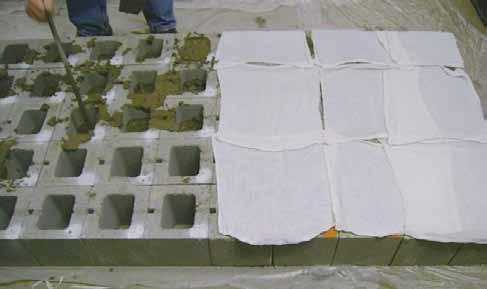
Figure 2: Grout samples during casting. Figure 3: Grout samples during testing.
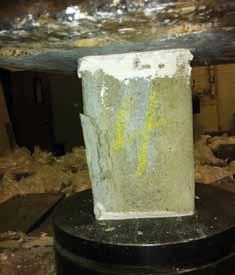
technology laboratory at the Canada Centre for Mineral and Energy Technology (CANMET-MTL) began developing a high volume fl y ash concrete (HVFAC). Th at concrete utilizes proper mixture proportioning and careful selection of materials to minimize the amount of Portland cement while producing high-quality concrete. HVFAC has low Portland cement content, low water-to-cementitious materials ratio (w/cm) and incorporates up to 55% fl y ash. Because of low w/cm, however, superplasticizers may be needed to increase fresh concrete workability. Over the years, CANMET-MTL, in partnership with the Electric Power Research Institute (U.S.A.) Canadian Electrical Association, and other public and private partners, has published a large amount of data on the properties of HVFAC. HVFAC has been gradually gaining acceptance among engineers.
Experimental Program at CMACN
A pilot testing program was conducted by the Concrete Masonry Association of California and Nevada (CMACN) to determine the feasibility of using higher substitution levels of fl y ash and slag for Portland cement. Tests were conducted using grout mixes with 20, 30, 40, 50, and 60% fl y ash replacement and mixes with 50, 60, and 70% Class F fl y ash and GGBFS replacement; in these latter mixes, the percentage of fl y ash was constant at 25 percent. Some of the results of that pilot research are shown herein for comparison.
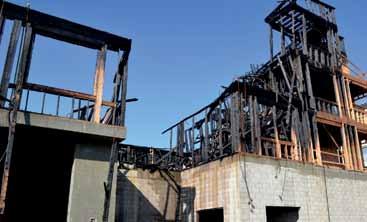

Experimental Program at BYU
A research program is being conducted at Brigham Young University (BYU) under the direction of Dr. Fernando Fonseca in collaboration with Mr. Kurt Siggard, Executive Director of CMACN. Th e fi rst phase of this research program was to test grout mixes with high volumes of fl y ash and slag. Th e second phase is under way and involves testing of masonry prisms with high volumes of fl y ash and slag grouts. Results of the fi rst phase are being reported in this article, and results of the second phase will be reported in a subsequent article. Chapter 3 of the Building Code Requirements for Masonry Structures specifi es that the compressive strength of grout, f'g, must be equal or exceed the specifi ed compressive strength of masonry, f'm, which in turn must be equal
WOOD BURNS, CONCRETE MASONRY DOESN’T.
In this construction fire photo, the wood frame has been completely destroyed, while the concrete masonry base remains intact.
Concrete masonry is safe. It does not burn, melt, or warp. Buildings made with concrete masonry are fire, weather, earthquake, flood, and mold resistant.
FIND OUT WHY YOU SHOULD CHOOSE CONCRETE MASONRY FOR YOUR NEXT PROJECT AT WHYMASONRY.ORG
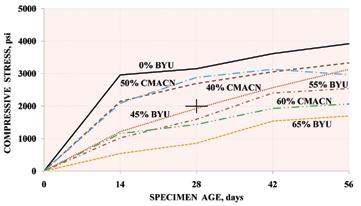
Figure 4: Grout strength – fly ash replacement set. Figure 5: Grout strength – fly ash-GGBFS replacement set.
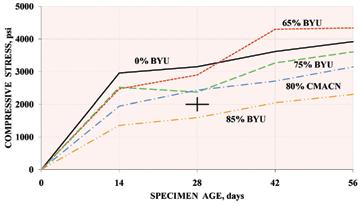
or exceed 1,500 psi at 28 days. Chapter 2 of the code, however, does not specify minimum compressive strengths for grout and concrete masonry. According to the Specification for Masonry Structures, however, concrete masonry must: comply with the unit strength method; have a grout compressive strength equal to or exceeding f'm but not less than 2,000 psi at 28 days; or meet ASTM C476 specifications, which require grout to have a minimum compressive strength of 2,000 psi at 28 days. All of this means that grout must have a minimum compressive strength of 2,000 psi or the f'm, whichever is greater. The first research phase evaluated compressive strengths of several grout mixes by comparing results obtained with results of CMACN pilot testing and determining which mixes reached the compressive strength of 2,000 psi at 28-days. The control mix had Portland cement as the only cementitious material. The second set of grout mix had 45, 55, and 65% replacement of Portland cement with Class F fly ash, and the third set of mix had 65, 75, and 85% replacement of Portland cement with both fly ash and GGBFS with the percentage of fly ash being constant at 25 percent. These percentages were chosen to possibly determine the upper volume limit of these materials without modifications to the typical grout manufacturing procedure. Grout mixes were proportioned by weight and the material mixed in a mechanical mixer in accordance with ASTM C476. The ratio of water-cementitious material remained constant at approximately 0.7, but slump varied slightly from mix to mix. Slump testing was conducted according to ASTM C143 and ranged from 8 to 11 inches. Specimens were constructed and tested per ASTM C1019 with one exception: grout was placed into the cores of 8 x 8 x 8 inch CMU to form the specimens, rather than the four CMU mold. This method provided the absorptive mold for the grout specimen as required by ASTM C1019. Grout samples were wet-cured in a fog room complying with ASTM C511. Compression specimens meeting the dimensional requirements of ASTM C1019 were saw-cut from the CMU cores using a wet diamond saw and then returned to the curing environment until testing. The saw-cut specimens were capped with capping compound and tested in compression in accordance with ASTM C1019. The testing of the grout samples occurred at 14, 28, 42, and 56 days. Figures 1 (page 10), 2 and 3 (page 11) show the samples prior to casting, during casting, and one sample being tested, respectively.
Results and Discussion
Testing results for the fly ash replacement set are shown in Figure 4. Results show some variability and even what appears to be some discrepancies. The capacity of the CMACN 40% and 50% specimens is similar up to 42 days but then there is a decrease in strength for the 50% set, which is atypical since fly ash mixes gain strength with time. The capacity of the BYU 45% set appears to be low; it is much lower than that of the CMACN 40%, which should not have been, and only slightly higher than that of the BYU 55% set. Also, the increase in capacity from the BYU 65% to the BYU 55% is significantly larger than that between the BYU 55% and the BYU 45%. Furthermore, based on results from the CMACN tests, the BYU 45% set was expected to achieve the minimum code requirement at day 28, which did not occur. These discrepancies may be due to the difference in materials and/or testing equipment and personnel. Nevertheless, results clearly show that 40% fly ash substitution achieves the code minimum required at 28 days and that 60% fly ash substitution achieves the code minimum required at 56 days. Testing results for the fly ash-GGBFS replacement set are shown in Figure 5. Results for the fly ash-GGBFS replacement set are more consistent than that of the fly-ash alone. There are still some irregularities and discrepancies, which are also most likely due to difference in materials and/or testing equipment and personnel. Nevertheless, results clearly show that 80% fly ash-GGBFS substitution achieves the code minimum required at 28 days and that 85% fly ash-GGBFS substitution achieves the code minimum required at 56 days.
Conclusions
High volume fly ash and GGBFS replacement of Portland cement is a viable alternative to make concrete masonry construction more economical and sustainable. Research presented clearly shows that 40% fly ash and 80% fly ash-GGBFS substitutions achieve the code minimum compressive strength required at 28 days, and that 60% fly ash and 85% fly ash-GGBFS substitutions achieve the code minimum compressive strength required at 56 days. Results, however, appear to be sensitive to regionally available materials used, testing equipment, and technicians conducting the tests; therefore, masonry grout mix designs incorporating high volumes of SCM’s should be evaluated and tested using regionally available materials by masonry grout suppliers. More research to determine the correlation between these factors and the compressive strength of masonry prisms, constructed with grout containing high volumes of supplemental cementitious materials, is necessary to achieve a confidence level before proposing any changes to current codes and standards.▪










